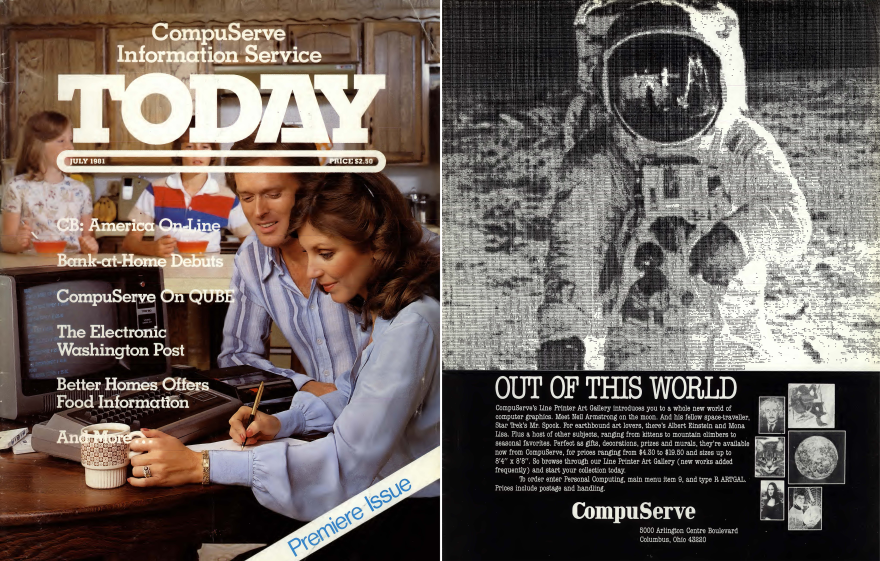Silicon Valley has the reputation of being the birthplace of our hyper-connected Internet age, the hub of companies such as Apple, Google and Facebook. However, a pioneering company here in central Ohio is responsible for developing and popularizing many of the technologies we take for granted today.
A listener submitted a question to WOSU’s Curious Cbus series wanting to know more about the legacy of CompuServe and what it meant to go online before the Internet.
That legacy was recently commemorated by the Ohio History Connection when they installed a historical marker in Upper Arlington — near the corner of Arlington Center and Henderson roads — where the company located its computer center and corporate building in 1973.
The plaque explains that CompuServe was "the first major online information service provider," and that its subscribers were among the first to have access to email, online newspapers and magazines and the ability to share and download files.

The company started in 1969 as a subsidiary of Golden United Life Insurance. It was initially a computer time-sharing service. It offered data processing power to businesses that didn't have their own mainframe computers.
Rich Baker started working in the marketing department for CompuServe in 1976 and was director of corporate communications when he left in 1996. (Baker is currently a co-host on WOSU's Bluegrass Ramble.)
"They were giant computers. They'd be like having 10 refrigerators stacked next to each other," Baker said. "It had flashing lights. They had spinning tape reels."
Baker said the company’s data processing business was doing very well in the late 1970's.
"It was serving some of the largest corporations in the country. But, you know, we still had those large mainframe computers that sat relatively idle in the evenings," Baker said.
So CompuServe tested the idea of giving that access to tech enthusiasts who were using these new devices called microcomputers. That developed into a business plan.

On September 24, 1979, CompuServe launched its online service for consumers.
In the beginning, RadioShack stores were key in reaching early computer users. Their TRS-80 desktop microcomputer was a popular choice when home computers first became available.
RadioShack marketed MicroNet, later rebranded CompuServe Information Service, alongside new computers and modems. In 1980, H&R Block acquired the company.
Former tech journalist Dylan Tweney covered the industry for decades and was an early Compuserve user. He still remembers his first email address, 72241.443@compuserve.com. He also remembers the first email he sent.
"I sent an email to my dad," Tweney said. His father, who was a professor at a university, had email access relatively early. "I was so proud," he said.
In those days, users would sit at their computers and dial a phone number with their modems, sometimes placing an actual phone receiver onto the device.
"The modem would make this hellacious noise. It would kind of screech and squawk," Tweney said.
Once the connection was made, users would see the CompuServe menu.
"You'd be online and on your computer screen was a bunch of text," Tweney said. "So you'd get a menu of options that would appear as green text on your black monitor and you would type commands or press numbers to indicate which menu item you wanted."
Those options included email, weather maps, stock quotes, online shopping and even booking airline tickets.
The speed was slow—about 30 or 40 million times slower than what we’re used to today. But for the first time, users could read the newspaper online. In fact, The Columbus Dispatch was the first online newspaper. The Associated Press and other major newspapers soon followed.
Tweney said that while those features were impressive, CompuServe learned quickly that what computer users really wanted was human connection.
"But it turned out that what was most popular is not reading reliable news sources, but just shooting the breeze with your friends or arguing with strangers over politics," Tweney said.
On CompuServe, this took place on something called the CB Simulator. It was basically an online chat. The name, “CB”, referred to the CB radios that gained popularity in the 70s.

Will Cowman started using CompuServe as a teenager and later went to work for the company. He said he would often use up his weekly allowance for an hour of time online, which cost $5 an hour.
Cowman said he enjoyed playing CompuServe's interactive text-based adventure games, but it was the CB Simulator that really grabbed him.
"I was very intrigued by my ability to communicate with people all around the world who didn't make any judgments about the fact that I was 14," Cowman said.
CompuServe also had popular forums that were divided into various areas of interest, everything from needlepoint to NASA. Cowman said that there were thousands of these forums.
"These communities I connected to were really supportive and really interesting," Cowman said. "People were very eager to help out and share and expand their online community."
CompuServe remained competitive with the other big online services, such as Prodigy and AOL, through the mid-1990s. However, none of these services were able to fully adapt to the huge shift that came with the internet and the World Wide Web, which was a wilder place where anyone could create their own website.
AOL acquired the CompuServe service in 1997 from H&R Block. After that, remnants of the brand would survive for many years, but its heyday had passed.
According to Dylan Tweney, CompuServe should be remembered as a pioneer of digital community.
"For a lot of people, CompuServe was a connection to the world and their first introduction to the idea that their computer could be more than a computer. It was a communications device, an information device,” Tweney said.
Thanks to Chris Marshall for submitting this question to Curious Cbus. Submit your question below.



